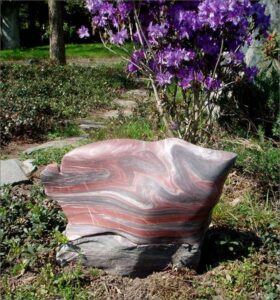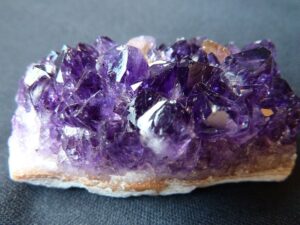
Home » Carve » Hard Stone » Grin and Barite – Nov/Dec 1999
Barite is a horrible name for selling stone. It has no cachet whatever. If anything, the name has the ring of something you don’t want even close. It sounds radioactive. Before now, no one has even suggested using barite as a carving stone.
Here is some information on a new stone for the sculptor. Barite, mined worldwide, has many industrial applications. Barium-the element derived from barite, the mineral-is used in the manufacture of glass and paint and is used as “drillers’ mud” at oil rigs. It is used medically. In diagnostic enemas, doctors don’t hesitate to put it memorably close to patients. Unless you drop the heavy stuff on your toe, barite is no more harmful that most any other rock. When I inquired with OSHA, I was told it could be considered benign. It is not radioactive. Too bad barite sounds like something that could light your bones green. Terrible name. There has to be something better, a trade name.
Barite is very seldom found pure in nature. It typically comes mixed with other minerals of varying nasty hardness and ugly colors. This explains its lack of history as a sculpting media. Different, the barite from Prince of Wales Island is virtually pure as found. A report of chemical analysis conducted for past property owners by a private metallurgical Jab describes the barite as “a finely crystalline white rock containing no visible impurities.” Alaskan Barite is typically Ivory Soap white but has occasional blue-grey, lavendar, and gold tones. For so dense a mineral, it is surprisingly translucent. With a hardness similar to that of alabaster, it carves easily with hand tools. It comes from a deposit far too small and remote for commercial barium production.
How about calling it “Alaska Heavy Stone?” The name “barite” comes from the ancient Greek word for heavy. Its weight is perhaps its most distinguishing characteristic. Barite is 4.5 times heavier than water. By comparison, calcite, the main component of marble, is 2.7 heavier. When you place a sculpted piece of barite on the table, it wants to stay put. I used it as a ballast in my boat before I could afford pigs of lead. Because of its great relative weight, barite might make excellent base material for sculpture of other materials.
It has been hard to get people to try it. Janet Willing was the first to take the chance. A few unwillings have tried it, usually convinced only after great brow beating on my part. 1 asked Nicky Oberholtzer to write her appraisal.
Barite is a very pleasing stone to carve. It responds well to the die grinder and the angle grinder. For beginners, who are using hand tools, it is ver)’ easily worked. Caution should be exercised when using chisels as the stone is fairly brittle and more may come off than you planned. For those who hate sanding and polishing, the stone is a welcome surprise because it takes less effort to sand than most and the results are immediate. It takes an incredible shine without much effort und is silky smooth to the touch by the time you have finished with 220 grit.
Nicky is now recommending barite to her students. But. what to call it? How about: “Alaskan Wonder Stone?” No, that one gets a finger down the throat.
l once had on the boat a young intern geologist with the USGS. From Texas, he identified the mineral “BAY-rite.” For the rest of our trip his veteran colleagues dubbed him “the BAY-rite kid.”
Alaskan barite comes from the tip of a penn insula that protrudes into a very open area of ocean. Like most beach cobbles (note the barnacles) the stone can only be gathered when the seas are at their calmest. The location might be accessible only thirty days a year. Typically, I anchor my bigger boat in a protected cover about a mile away and go to the barite site in my skiff. If you happen to be there at a very low tide, you can also gather abalone and rock scallops. That happened once.
My first two attempts to collect there this year were unsuccessful. Twice I believed a favorable weather report. Twice I was foiled by the seas-the waves pounding on the exposed beach would have pooped the skiff at the landing or swamped it at sea had I dared a heavy load. The location is seven hours by boat, one way, from my home port of Craig. A lot of time and diesel were burnt for naught.
“Bear-ite” might work. Think of the possibilities if I could get the native population here to use it, instead of soapstone, to carve polar bears. In spite of barite’s near perfect color, all my attempts in this direction have failed. I’ve heard a similar story of a Canadian sculptor who failed to get Eskimos to work a beautiful white marble in their back yard.
I did not use the Hyak on my third attempt. A couple of fishermen, who live on a boat moored near mine, offered the hire of their backs and their boat to gather stone. Better than my boat for the chore, theirs had a large fish hold and a boom that could be used to swing aboard tone delivered by skiff from the shore. The trip took longer than expected. By the time we got to the location, the tide had already covered most of the barite on the beach. The tide was not going to be low enough again to gather stone until around mid-night. We anchored and discussed possibilities. It was either gather stone in the dark of night with a flashlight or wait until around noon the next day. They said they had to be back in town and offloaded before a pending commercial fishing opening. We set the alarm for eleven p.m. and crawled into our bunks for the couple hour wait for low tide.
The tide was still dropping when we got to the beach. It was necessary for one of the fishermen, wearing chest waders, to remain standing in the surf to hold the skiff-it had to be kept in water shallow enough to be loaded but also deep enough for it to not “high center” on one of the random boulders of the intertidal zone. The other fisherman and I carried barite cobbles in the dark, holding little plastic flashlights between our teeth. We carried the stones, one or several at a time, out into the water to the tops (sometimes over the tops) of our rubber boots. The man in the chest waders, splashing phosphorescence, relayed the arm loads of stone to the side of the skiff, where he placed them over the gunwale.
“BARITE.” It’s a lousy namefor a finecarving stone. but, I’ll just have to accept it. Grin and barite. ‘”



We need some kind of descriptive text here.